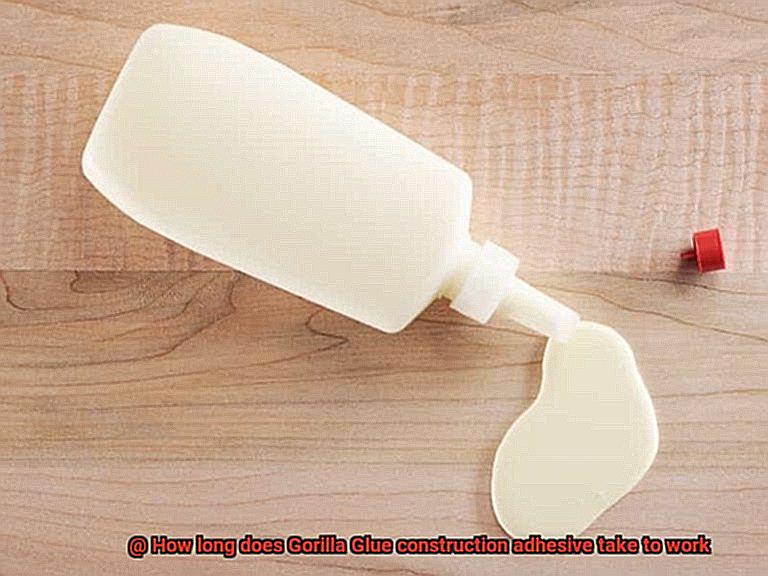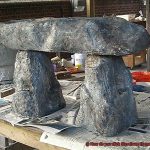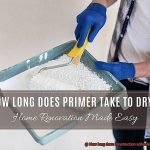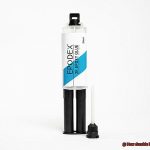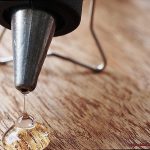When it comes to heavy-duty projects, finding the perfect adhesive that guarantees an unbreakable bond is absolutely essential. And with its legendary reputation for strength and durability, Gorilla Glue construction adhesive has become the go-to choice for professionals and DIY enthusiasts alike.
But let’s get down to business – just how effective is this glue? How long does it take for Gorilla Glue construction adhesive to work its magic? Well, my friend, we’re about to dive deep into the answer right here in this blog post.
Now, we understand that time is of the essence when you’re fixing up broken furniture or embarking on a grand remodeling adventure. Luckily, Gorilla Glue construction adhesive doesn’t mess around. With its incredible grip and lightning-fast curing capabilities, this adhesive gets the job done efficiently and reliably.
But what’s the secret behind its effectiveness? It all boils down to understanding the fascinating process of curing. You see, Gorilla Glue construction adhesive is specially formulated to react with moisture – whether it’s in the air or on the surface of the materials you’re bonding. This moisture activates the glue and kickstarts the curing process, resulting in a bond that only grows stronger over time.
So, how long does it actually take? Well, get ready for some instant gratification because you can expect the initial bond to start forming within mere moments after application. But here’s where patience becomes your greatest ally – allow this mighty adhesive enough time to fully cure. While drying time may vary depending on factors like temperature, humidity, and even the materials being bonded together, it’s generally recommended to leave your glued items undisturbed for at least 24 hours for optimal results.
Whether you’re using Gorilla Glue construction adhesive for carpentry masterpieces or woodworking wonders, rest assured that its power lies in creating a bond that can brave the toughest indoor and outdoor elements.
To sum it all up, Gorilla Glue construction adhesive is the ultimate solution for quick, reliable bonding during your most challenging construction endeavors. So whether you’re a seasoned pro seeking a trusted adhesive or a DIY enthusiast ready to conquer that home improvement project, Gorilla Glue construction adhesive has got your back – ensuring a bond that lasts.
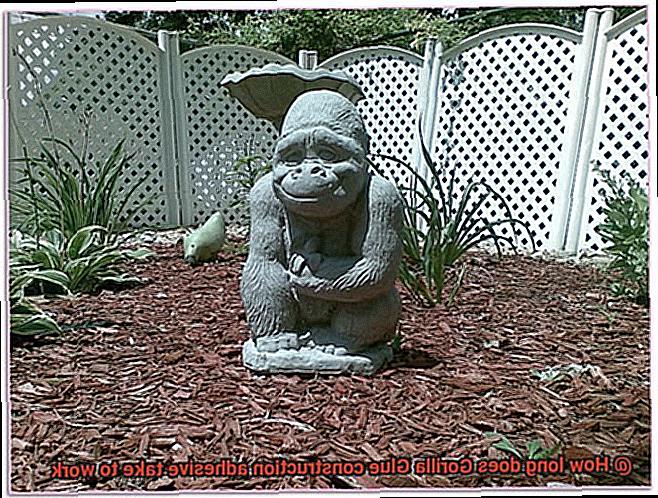
Stay tuned for more amazing tips and tricks on how to make the absolute most of this incredible construction adhesive in our upcoming blog posts.
Factors Affecting Curing Time
Contents
- 1 Factors Affecting Curing Time
- 2 Recommended Application Method
- 3 General Curing Time for Gorilla Glue Construction Adhesive
- 4 Effects of Temperature and Humidity on Curing Time
- 5 Heavy Loads Requiring Extra Curing Time
- 6 Caution During the Curing Process
- 7 Materials Not Compatible with Gorilla Glue Construction Adhesive
- 8 Testing for Compatibility Before Use
- 9 Conclusion
Gorilla Glue construction adhesive is a popular choice for bonding various materials in construction and repair projects. To achieve optimal results, it is essential to understand the factors that can affect the curing time of this adhesive.
In this blog post, we will explore how temperature, humidity, surface preparation, adhesive application, material type, bonding pressure, and cure time can impact the curing time of Gorilla Glue construction adhesive.
Temperature:
Temperature plays a crucial role in the curing time of Gorilla Glue construction adhesive. Higher temperatures accelerate the curing process, while lower temperatures slow it down. Extreme temperatures can also affect the bond strength and durability of the adhesive. Working in moderate temperature conditions is recommended for optimal results.
Humidity:
Humidity levels can influence the curing time of Gorilla Glue construction adhesive. Higher humidity levels extend the curing time as moisture in the air interferes with drying and hardening. Lower humidity levels expedite the curing process. Following manufacturer’s recommendations regarding acceptable humidity ranges is crucial.
Surface Preparation:
Proper surface preparation is essential for achieving a strong bond and reducing curing time. Surfaces should be clean, dry, and free from contaminants or residue that hinder adhesion. Roughening or sanding smooth surfaces improves bond strength and reduces curing time.
Adhesive Application:
The quantity of Gorilla Glue construction adhesive applied impacts its curing time. A thicker layer requires more drying and curing time. Follow manufacturer’s guidelines for appropriate application thickness for optimal results.
Material Type:
Different materials have varying absorption and moisture retention properties, affecting drying and curing times. Materials with higher porosity or surface roughness allow for faster adhesion and shorter curing times. Consider material type when estimating curing time.
Bonding Pressure:
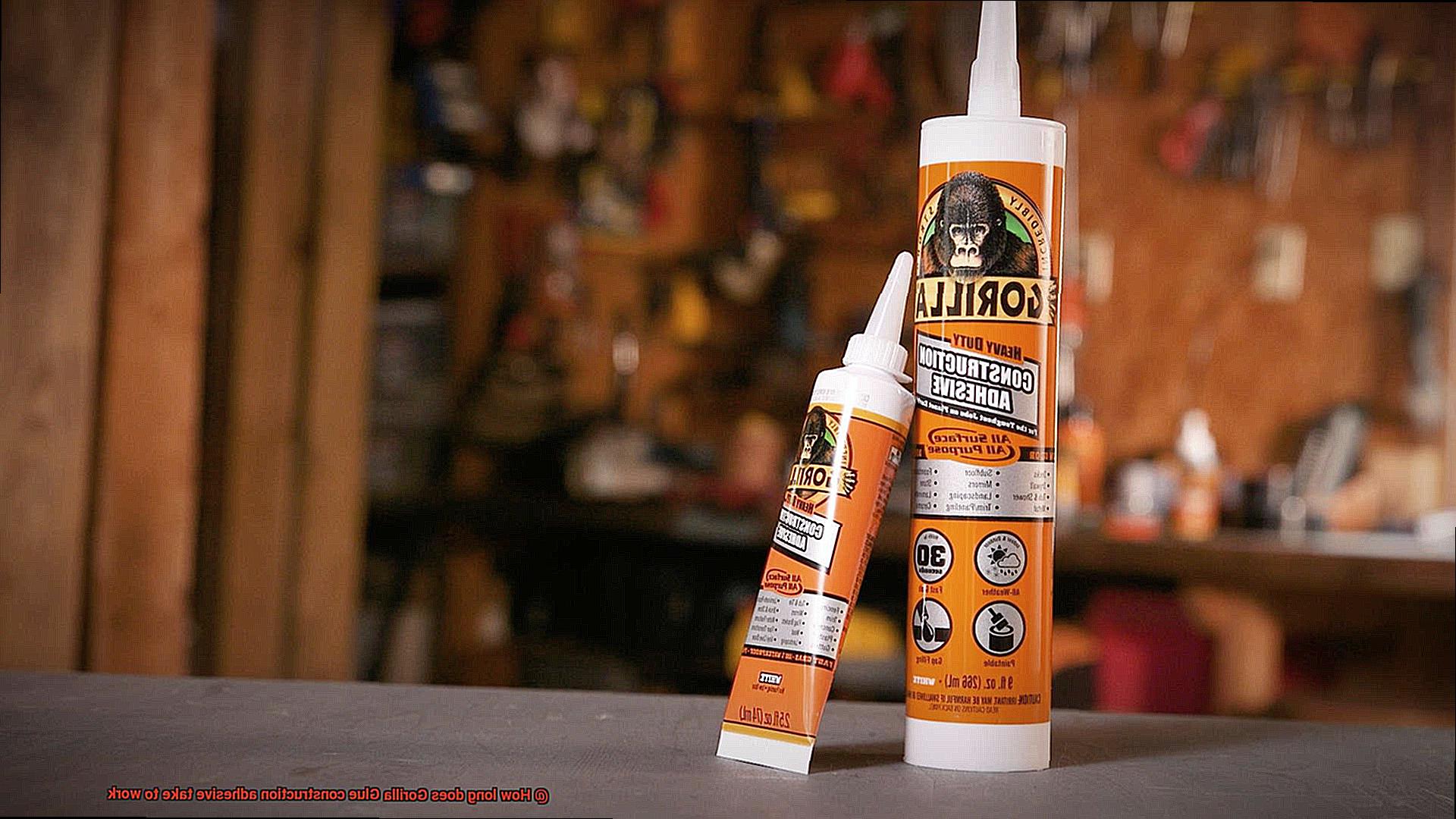
Applying proper bonding pressure promotes faster drying and hardening of the adhesive. It ensures maximum contact between the adhesive and surfaces being bonded. Use clamps or weights to maintain consistent pressure during curing.
Cure Time vs. Full Strength:
Gorilla Glue construction adhesive may cure within a specific timeframe, but achieving full bond strength takes longer. Follow the manufacturer’s recommended curing period before subjecting the bond to any stress or load.
Recommended Application Method
In this blog post, we’ll dive into the recommended steps to ensure a strong and durable bond that withstands the test of time. So, grab your glue gun and let’s get started.
Step 1: Prepare the surfaces:
To achieve a robust bond with Gorilla Glue, it’s crucial to start with clean and dry surfaces.
Dust, grease, and other contaminants can hinder adhesion, so grab a mild detergent or rubbing alcohol and give those surfaces a thorough cleaning.
This ensures that the glue adheres to the materials without any interference.
Step 2: Apply a thin layer:
Less is more when it comes to Gorilla Glue. Apply a thin layer of glue to one of the surfaces. Remember, excess glue can weaken the bond, so go easy on it. Trust us, a little dab will do. Applying too much glue not only wastes product but also leads to messiness and an inefficient bond.
Step 3: Bring it together:
Quickly bring the two surfaces together and firmly press them. Applying pressure helps the glue spread evenly, ensuring strong contact between the materials. This step is crucial to create a secure and long-lasting bond.
Depending on the project, clamping or using weights may be necessary to hold everything in place while the glue cures. Don’t underestimate the power of pressure.
Step 4: Give it time:
Patience is key. Let the glued surfaces cure undisturbed for at least 24 hours. During this time, avoid any movement or stress on the bonded area as it can compromise the strength of the bond.
This waiting period allows the glue to fully set and develop its maximum bond strength, ensuring a durable hold that stands the test of time. Remember, good things come to those who wait.
Step 5: Enjoy your masterpiece:
Once fully cured, Gorilla Glue forms a strong bond that can withstand various stresses and strains. However, keep in mind that maximum bond strength may take up to 72 hours to develop. So, hold off on lifting those heavy weights for a little longer. Once the bond is fully cured, you can confidently admire your masterpiece knowing that it is securely held together.
Bonus tip: Accidental spills and excess glue can be a nightmare. Wipe off any excess immediately with a damp cloth before it dries. If you’re dealing with dried glue, acetone or nail polish remover can come to the rescue. Just remember to test them on an inconspicuous area first. This will help you maintain clean and precise workmanship.
General Curing Time for Gorilla Glue Construction Adhesive
Curious about the magic behind strong adhesive bonds? Enter Gorilla Glue construction adhesive. Renowned for its strength and versatility, this adhesive is a favorite among DIYers and professionals alike.
But how long does it take for this potent potion to work its wonders and create a bond that can withstand the test of time? Let’s explore the mysteries of Gorilla Glue construction adhesive curing time and discover the factors that can influence it.
Factors that Impact Curing Time:
Temperature:
Just like humans, glue has temperature preferences. Higher temperatures speed up curing, while lower temperatures slow it down. For optimal results, use Gorilla Glue construction adhesive in temperatures between 40°F and 100°F (4°C and 38°C). Extreme temperatures outside this range may affect performance and curing time.
Humidity:
Humidity levels also play a role in curing time. Higher humidity accelerates the process, while lower humidity prolongs it. Working in a humid environment? Expect faster setting times compared to dry climates.
Materials Being Bonded:
Different materials absorb moisture at different rates, affecting Gorilla Glue construction adhesive’s curing time. Porous materials like wood or fabric absorb more moisture, extending the process. Non-porous materials like metal or plastic have quicker curing times.
Best Practices for Optimal Results:
Follow Instructions:
To achieve the best outcome, adhere to Gorilla Glue’s instructions. Apply a thin layer to both surfaces, let them sit for a few minutes to activate the adhesive, then firmly press them together.
Apply Pressure:
After joining the surfaces, clamp or weigh them down for at least two hours. This maintains pressure between them, ensuring optimal adhesion. Avoid subjecting the bond to stress or load during the curing process, which weakens the adhesive and compromises strength.
Be Patient:
While Gorilla Glue construction adhesive generally cures in 24 hours, maximum bond strength may take longer. In some cases, it could take up to 72 hours or more. Resist testing the bond too soon, and exercise patience for lasting results.
Effects of Temperature and Humidity on Curing Time
The effects of temperature and humidity on the curing time of Gorilla Glue construction adhesive are fascinating and crucial to achieving fast and effective bonding. Let’s dive into the details.
Temperature is a key player in the curing process. Higher temperatures can turbocharge the curing time, while lower temperatures put on the brakes. Why? Well, temperature influences the chemical reactions that occur within the adhesive. When exposed to heat, the molecules in the glue become electrified, resulting in rapid bonding and solidification. Conversely, colder temperatures slow down molecular movement, leading to a snail-paced curing process.
But beware. Extreme temperatures, whether scorching or freezing, can wreak havoc on the adhesive’s performance. To hit the sweet spot, it is generally recommended to use Gorilla Glue construction adhesive within a temperature range of 50°F to 90°F (10°C to 32°C).
Now let’s talk about humidity. Did you know that humidity levels also hold sway over the curing time of Gorilla Glue? Higher humidity can extend the drying process by impeding moisture evaporation from the adhesive. In other words, when the air is saturated with moisture, it teams up with the glue, causing it to take its sweet time to dry and harden.
On the flip side, in low humidity conditions, moisture evaporates faster from the adhesive, leading to a speedier curing time. However, striking a balance is key. Maintaining moderate humidity ensures proper bonding and prevents issues such as overly rapid drying that could result in weak adhesion.
So how do you optimize the curing time of Gorilla Glue construction adhesive? The answer lies in working in a controlled environment with moderate temperature and humidity levels. This ensures consistent and reliable results.
Remember, though, that temperature and humidity are not the only variables at play. Surface porosity, material type, and application method can also affect curing time. Following the manufacturer’s instructions and allowing sufficient time for the adhesive to fully cure before subjecting it to stress or load-bearing activities is essential.
Heavy Loads Requiring Extra Curing Time
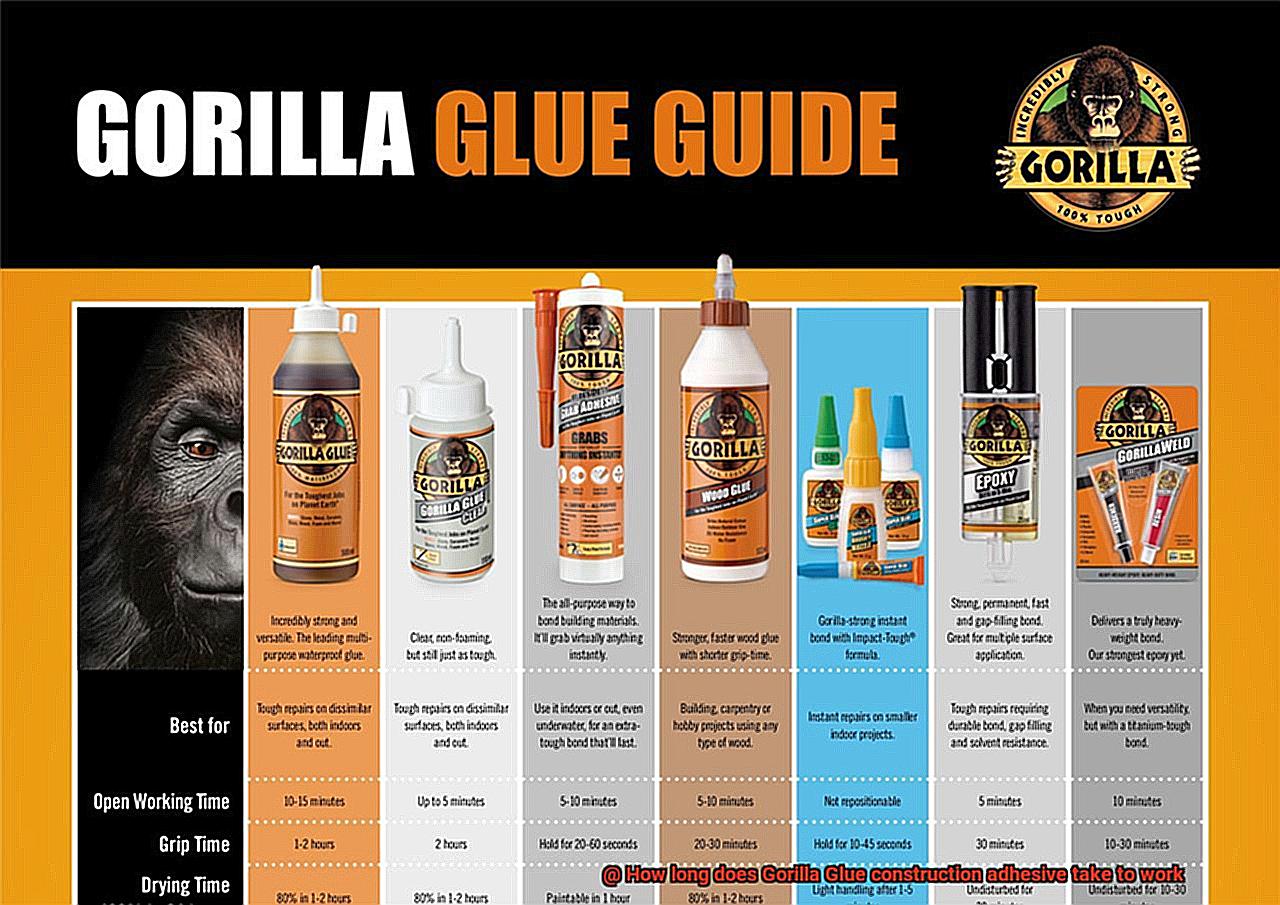
When it comes to heavy loads and Gorilla Glue construction adhesive, patience is key. We all know that Gorilla Glue is a powerful adhesive that can withstand tough conditions. However, when dealing with heavy loads, it’s important to give it some extra curing time to ensure a strong and durable bond.
Heavy loads put more stress on the bond between materials, so rushing the curing process can compromise its strength and durability. Nobody wants their hard work to come crashing down, right? That’s why it’s best to wait at least 48 hours before putting any stress or weight on those bonded materials.
So why is this extra time so crucial? By allowing that additional curing time, we give the adhesive ample opportunity to fully cure and create a super strong connection between materials. This ensures that the bond can withstand the demands of heavy loads.
But let’s not forget about our trusty sidekicks, temperature and humidity. Higher temperatures generally speed up the curing process, while lower temperatures may slow it down. Similarly, higher humidity levels can accelerate curing, while lower humidity levels might make things take a bit longer.
And here’s a pro tip: when dealing with heavy loads, it’s always a good idea to provide some additional support or clamping during the curing process. This ensures that the materials stay in place and maintain proper alignment while the adhesive works its magic.
Caution During the Curing Process
In this blog post, we will explore the importance of exercising caution during this critical step and provide you with key points to ensure successful projects.
Understand the Curing Process:
The curing process refers to the time it takes for Gorilla Glue construction adhesive to fully dry and harden, creating a strong bond. Factors such as temperature, humidity, and the materials being bonded can influence the curing time, typically taking around 24 hours.
Read and Follow Instructions:
Before beginning your project, take a moment to read and follow the instructions provided by the manufacturer. These guidelines may include specific recommendations for curing times based on the product you are using.
Keep Surfaces Dry:
Excessive moisture can prolong the curing process. Ensure that the surfaces you are bonding are as dry as possible during application and curing to expedite the curing time and ensure a strong bond.
Avoid Disturbing Bonded Surfaces:
During the curing process, it is crucial not to disturb or stress the bonded surfaces. Avoid any movement or excessive handling of the objects being glued together, as this can weaken the bond.
Apply Pressure Appropriately:
While pressure is necessary during the initial bonding process for proper adhesion, be cautious not to apply excessive pressure during curing. Excess pressure can cause the adhesive to squeeze out and compromise the bond’s strength.
Ventilation is Key:
Some adhesives release fumes during curing. To protect yourself, work in a well-ventilated area or use appropriate respiratory protection if needed.
Avoid Extreme Conditions:
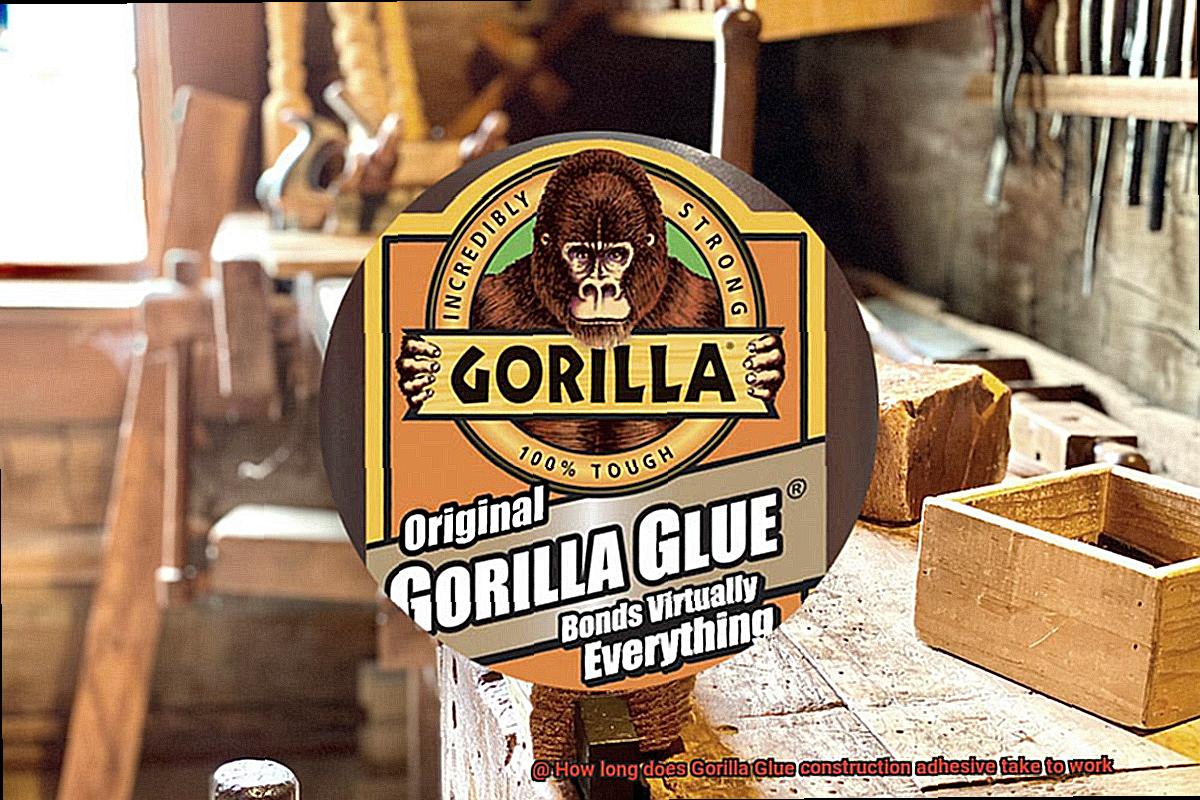
Once the adhesive has fully cured, it forms a strong bond. However, it is important to avoid exposing the bonded surfaces to extreme temperatures or harsh chemicals, as this can affect the longevity of the bond.
Safety First:
In case of accidental spillage or contact with skin or eyes, refer to the safety precautions provided by the manufacturer. If necessary, seek appropriate medical attention promptly.
Materials Not Compatible with Gorilla Glue Construction Adhesive
This powerhouse adhesive is renowned for its unparalleled strength and durability, making it a top choice for both DIY enthusiasts and professionals alike. However, it’s crucial to understand that Gorilla Glue construction adhesive is not compatible with all materials.
One material that simply won’t see eye to eye with Gorilla Glue is polyethylene or polypropylene plastic. These plastics possess a low surface energy, making it incredibly challenging for the glue to establish a strong bond. When working with these types of plastics, it’s best to seek out specialized adhesives that are explicitly designed for bonding them.
Silicone is another material that poses a challenge for Gorilla Glue construction adhesive. With its smooth and non-porous surface, silicone presents a formidable obstacle for the glue to adhere to effectively. To overcome this hurdle, consider using a silicone-based adhesive or a specialized silicone sealant for optimal results.
Certain metals, such as copper or brass, may also prove to be incompatible with Gorilla Glue construction adhesive. These metals possess low surface energy and can potentially be contaminated with oils or other substances, making bonding a bit more complicated. For metal bonding projects, ensure that the surface is thoroughly cleaned and prepared before applying the glue. In some cases, using a metal-specific adhesive may be necessary.
Last but not least, certain rubber or vinyl materials may not be the best match for Gorilla Glue construction adhesive. These materials often exhibit low surface energy and may require the use of specialized adhesives specifically designed for rubber or vinyl bonding.
Always remember to carefully read and follow the instructions provided by the manufacturer when working with any adhesive product, including Gorilla Glue construction adhesive. This will ensure that you are using the product correctly and achieving the strongest possible bond.
Testing for Compatibility Before Use
Don’t skip the crucial step of testing for compatibility. This small investment of time and effort will save you from potential disasters and ensure the success of your project. Let’s explore why compatibility testing is important and how to do it right.
Why Compatibility Matters:
Prevents Adverse Reactions:
Applying Gorilla Glue without testing for compatibility can lead to discoloration, warping, or damage to your materials. By conducting a simple test on a hidden or inconspicuous area, you can spot any adverse reactions before it’s too late.
Factor in Expansion:
Gorilla Glue has a unique characteristic – it expands as it cures. Imagine the horror of seeing your carefully bonded materials crack or break due to unexpected expansion. By testing for compatibility, you can leave sufficient space for expansion and avoid any unpleasant surprises.
Surface Preparation is Key:
Clean, dry, and contaminant-free surfaces are essential for strong adhesion. Compatibility testing allows you to assess whether your materials are properly prepared, ensuring optimal bonding strength and preventing potential failures.
Testing for Compatibility:
Apply a Small Amount:
Place a tiny drop of Gorilla Glue on both materials’ hidden areas and observe any reactions over time. Look out for discoloration, warping, or any other signs of incompatibility.
Timing is Everything:
Determine the working time of the adhesive by applying a small amount on a disposable surface. Time how long it takes for the glue to become tacky or set. This gives you an idea of how much time you have to work with before it starts curing.
Variant-Specific Instructions:
Remember, Gorilla Glue offers various variants of construction adhesive, each with its own characteristics and curing times. Always refer to the specific variant’s instructions for accurate information on compatibility and curing.
Ccvj1sFWxw8″ >
Also Read: Construction Adhesive – Glue Things
Conclusion
The time it takes for Gorilla Glue construction adhesive to work depends on several factors.
Generally, it starts to bond within 1-2 hours, but full curing can take up to 24 hours. This adhesive is known for its strong and durable hold, ensuring that your construction projects stay intact.
With Gorilla Glue, you can trust that your materials will be securely joined together.

